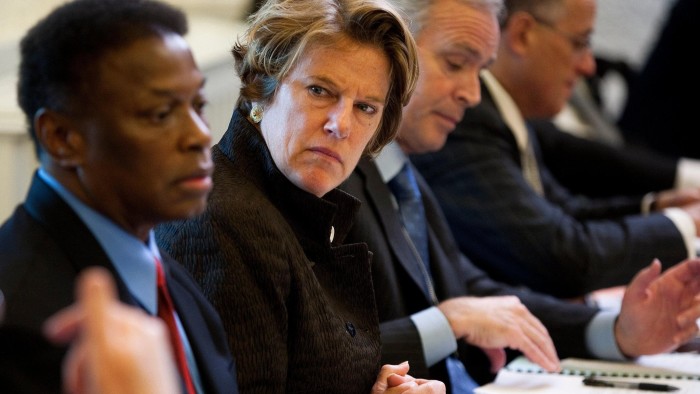Elizabeth Littlefield: ‘Not all social investment has to make a market return’

Roula Khalaf, Editor of the FT, selects her favourite stories in this weekly newsletter.
Elizabeth Littlefield, a US development veteran, has mixed feelings on a finding that almost two-thirds of impact investors are looking for market-rate returns with the rest seeking less.
While she celebrates a mainstreaming of impact investment — revealed in the latest survey from the Global Impact Investing Network (GIIN) — she argues that attention must also be paid to the needs of investors who care more about social impact than financial return.
“I find it ironic that we’ve spent the better part of the past decade trying to demonstrate that you could have a positive social impact as well as a market rate of return,” she says. “And now, we find ourselves making the point that not all social investment has to make a market return.”
Having spent time in both global development and private sector banking, Ms Littlefield has experienced both ends of the spectrum.
From 1984 to 2000, she worked at JPMorgan. But on a leave of absence from the bank, she helped to build microfinance institutions in west and central Africa. Then as chief executive from 2000 to 2010 of the Consultative Group to Assist the Poor, a multi-donor body housed at the World Bank, her mission was to establish a professional, global microfinance industry.
But it was perhaps her time as president of the Overseas Private Investment Corporation under the Obama administration that brought her closest to the principles of impact investing.
OPIC, the US government’s development finance institution, mobilises private capital to help solve pressing development problems. It is this idea Ms Littlefield is continuing to promote as a senior adviser at Albright Stonebridge Group, a global business strategy firm chaired by Madeleine Albright, former US secretary of state.
“I’ve always felt that with a little help, business could be harnessed as a force for good in the world,” she says. “That was the essence of what I was doing at CGAP and that’s what OPIC is all about.”
Today banks, funds and individuals are all starting to call themselves impact investors. So how does Ms Littlefield define it? For her, impact investing is related but not the same as socially responsible investing or investing using an ESG (environmental, social and governance) lens.
“The ESG movement is incredibly important — that’s making sure your investments are sustainable and not irresponsible or destructive,” she says. “But it’s distinct from having your investment have the purpose of creating social good.”
Building the segment of the market that is more focused on social impact, she says, will mean offering asset owners a wider and more tailored array of investment opportunities.
These might include financial products designed for someone who, for example, wants to invest in Latin America with a commercial rate of return but does not need the cash back for 30 years, or someone who will accept below-market returns to advance girls’ education in Africa but wants to visit those projects three times a year.
“Those are the kinds of opportunities where you might not have a fully market rate of return but you’re offering the investor a set of other things,” she says.
A number of gaps exist in developing these kinds of products. For example, socially-driven investment demands sufficient numbers of commercially viable mission-oriented companies. “We’re not really clear on whose job it is to built the pipeline of investment-ready opportunities,” says Ms Littlefield.
She also notes the lack of widely accepted impact measurement tools. Some work has been done on creating such tools. For example, to measure social or environmental returns, the GIIRS (Global Impact Investing Rating System) uses an approach similar to the S&P’s credit risk ratings or Morningstar’s investment rankings.
Meanwhile, the GIIN has created the Impact Reporting & Investment Standards, which provides a common set of definitions for impact
“Most investors today use their own cocktail of common frameworks,” she says. “We need to get simpler and more universal metrics that enable some kind of cross-market comparison.”
What also requires development is what Ms Littlefield calls the “plumbing” of impact investing. This market infrastructure, should include intermediaries who can bring investors and investments together, rating agencies and a secondary market, providing opportunities for investors to exit investments.
Above all, however, Ms Littlefield would like to see the impact investment sector broaden to accommodate all investors, large or small, institutional or individual, philanthropic or commercial.
“We’ve done a great job of creating awareness, building opportunity and generating an enormous amount of commercial capital — and that needs to continue,” she says. “But we also need to build out opportunities of a different sort that aren’t necessarily purely commercial.”
And although she believes private capital can solve many of the world’s social problems, Ms Littlefield also sees a new challenge: the fact that lifting people from poverty and increasing human prosperity could contribute to climate change and place a heavier burden on natural resources.
“How does impact investing meet the legitimate aspirations of this growing global middle class while safeguarding the planet? That’s the existential question for me, and one we don’t yet address effectively.”

Comments